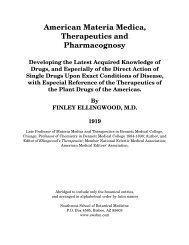SCARLET FEVER. Synonyms.—Scarlatina; Scarlet Rash. Definition ...
SCARLET FEVER. Synonyms.—Scarlatina; Scarlet Rash. Definition ...
SCARLET FEVER. Synonyms.—Scarlatina; Scarlet Rash. Definition ...
You also want an ePaper? Increase the reach of your titles
YUMPU automatically turns print PDFs into web optimized ePapers that Google loves.
Tuberculosis of the Kidney.—Tubercular nephritis is that condition<br />
where the tubercle bacilli develop in the inflammatory products,<br />
resulting in the formation of tubercular tissue. The inflammation<br />
usually begins in the mucous membrane of the pelvis and calices,<br />
gradually extending to the parenchyma, till more or less of the organ is<br />
replaced by the degenerated material. The tubercle may caseate and<br />
soften, or calcification may occur, the intervening space being converted<br />
into fibrous tissue. The other kidney is very apt to become involved, if<br />
not tuberculous, at least by a low form of nephritis and more or less of<br />
degeneration of its tissue and blood-vessels. Tubercular nephritis may<br />
be complicated by tuberculosis of other parts of the genito-urinary tract,<br />
by tuberculosis of the peritoneum, or, in fact, by tuberculosis of any<br />
other part of the system.<br />
Symptoms.—The urine is more or less scanty, and contains, at<br />
different times, blood, pus, epithelium, tubercle bacilli, and, when the<br />
other kidney is the seat of chronic nephritis, albumen and casts are<br />
present. Pain of a dull, aching character over the affected organ may be<br />
constant, or there may be paroxysms, occurring at intervals. The kidney<br />
may become enlarged, so that the tumor mass may be readily felt. As<br />
the disease advances, the general symptoms characteristic of<br />
tuberculosis are seen; viz., hectic fever, night-sweats, and general<br />
emaciation.<br />
Tuberculosis of the ureters and bladder may be a complication<br />
extending from the kidney, but rarely, if ever, occurs as a primary<br />
lesion. The same may be said of the prostate gland and vesiculse<br />
seminales.<br />
Tuberculosis of the Testicle.—This form of the disease may be either<br />
primary or secondary, and occurs more frequently in early life than in<br />
later years. In twenty cases reported by Julian, twelve were under two<br />
years of age. Tubercle of the testes is most often confounded with<br />
malignant growths and syphilis. A careful examination of the body at<br />
large and a complete family history are important, before a diagnosis is<br />
made.<br />
Tuberculosis of the Fallopian Tubes, Ovaries, and Uterus.— These<br />
organs are usually involved secondarily, although, in rare cases, they<br />
are the seat of the primary lesion. This is especially true of the tubes,<br />
while that of the ovary and uterus will always be found in connection<br />
with general tuberculosis.<br />
The Eclectic Practice of Medicine - PART I - Infectious Diseases - Page 209

















